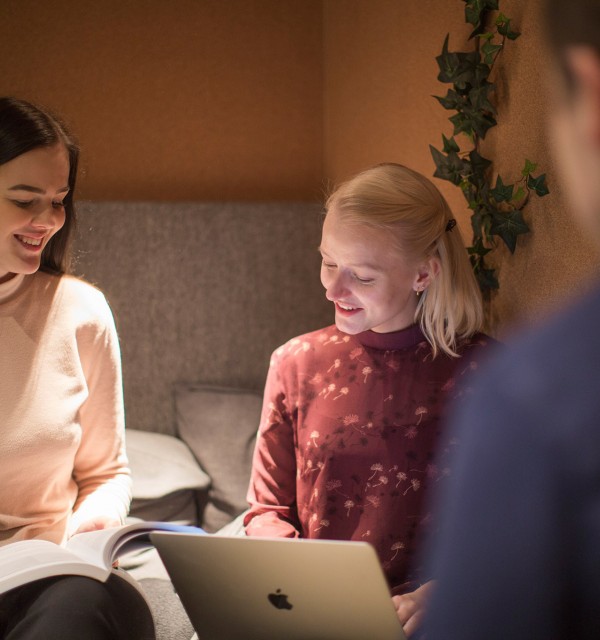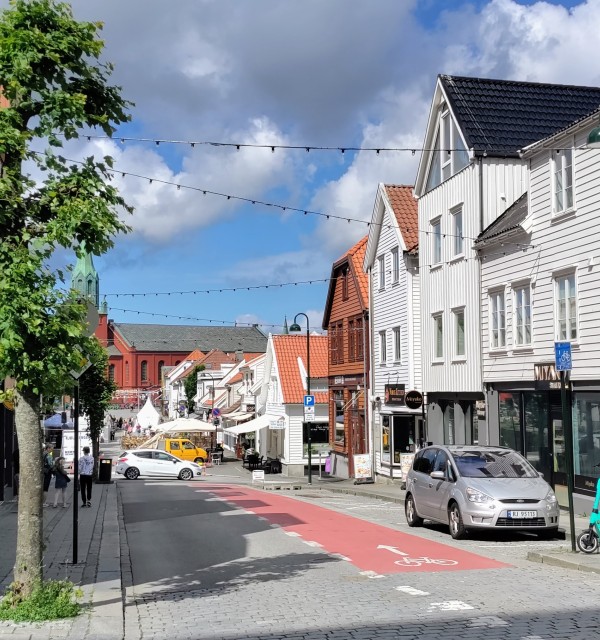Creating a smart city requires joint efforts of city planners, technologists, energy experts, social scientists, artists and others.
48
24
2020-2024
University of Stavanger conducts interdisciplinary research in the field of smart cities and collaborate with other organizations involved in this field.
Tomorrow's society must be more environmentally friendly, efficient, and user-friendly than it is today. To achieve this, we have to find new and better solutions for our citizen, and this requires research, development, and collaboration between various academic disciplines and not least collaboration between public and private sectors.
Many researchers at the University of Stavanger are involved in smart city related research and development projects. They represent very different disciplines, including urban planning, information technology, security, economics, politics, innovation, education, and the arts and culture.
Recently, the University of Stavanger has chosen Smart City as a strategic priority and has established a university-wide smart city research network to further strengthen this area.
Research projects
PhD projects
The Smart City Research Network has initiated a number of PhD projects, across many disciplines.
Using public resources for the development of technologies in the context of Smart Specialization
Smart Specialisation is an academic concept and innovative policy approach that aims to boost sustainable growth, levels of employment and social cohesion in Europe, by enabling each region to identify and develop its own competitive advantages.
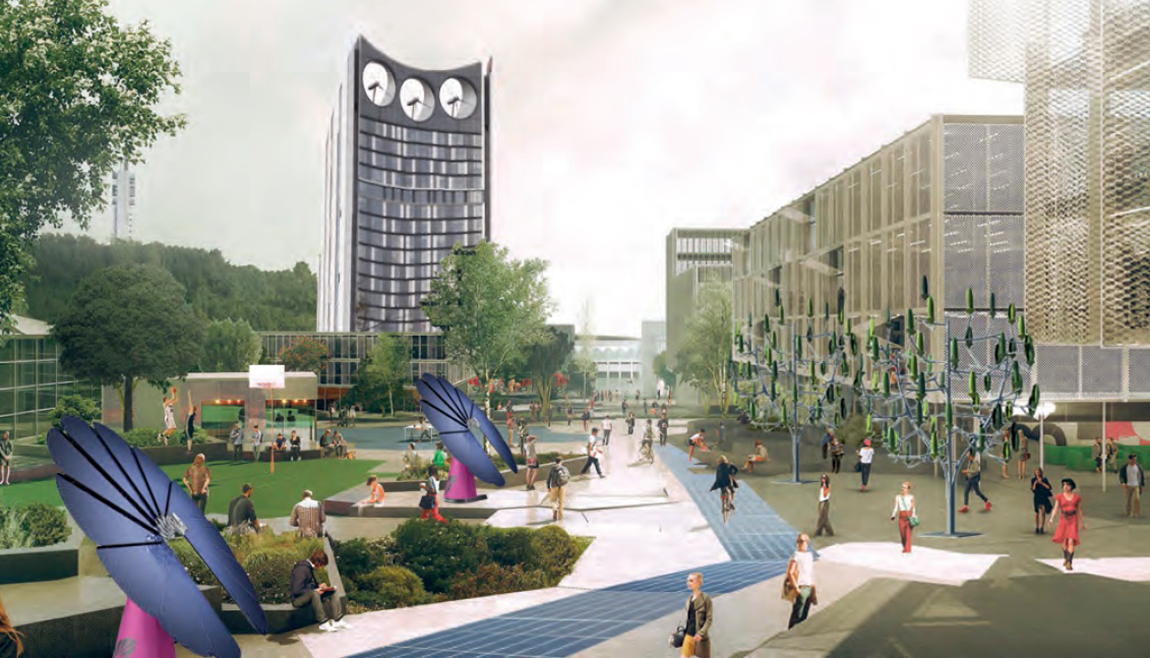
Smart Specialisation is an academic concept and innovative policy approach that aims to boost sustainable growth, levels of employment and social cohesion in Europe, by enabling each region to identify and develop its own competitive advantages. The process of setting up Smart Specialisation is known as Research and Innovation Strategies for Smart Specialisation (RIS3) and involves different stakeholders such as local authorities, academia, civil society, businesses and entrepreneurs.
The operationalization of smart specialization builds on a policy framework around the concepts of relatedness and knowledge complexity. Regions possess certain capabilities, being a combination of the region’s infrastructure and built environment, natural resources, institutional endowment, and knowledge and skills. Related activities demand similar capabilities; thus, relatedness matters in the regional diversification process. The value of knowledge or technologies (a manifestation of knowledge) is heterogenous. Simple knowledge, that is easy to copy possesses less economic value than complex knowledge that is difficult to imitate and more sticky in space. Diversifying into more complex technologies is attractive for European regions, but difficult to accomplish. Developing complex technologies involves various potential risks, and rewards. Regions can overcome this diversification dilemma by developing new complex technologies that build on local related capabilities.
The PhD project examines the various ways in which public authorities can meaningfully contribute to the development of technologies. The project scrutinizes how and to what extent public authorities can contribute to the invention of complex technologies, whose development process is characterized by risk and uncertainty. This part builds on Mariana Mazzucato's concept of the entrepreneurial state, which, according to Mazzucato, can make risky investments. Therefore, public support might be critical to the development of complex technologies. Overall, the project aims to contribute to the discussion on how public resources can be used best for the development of (complex) technologies.
Doctoral fellow in the project: Carolin Nast, UiS Business School, Department of Innovation, Management and Marketing.
Promoting sustainable residential energy behaviour through smart digital solutions
With an increasing proportion of citizens willing to make significant lifestyle changes and contribute to the sustainable development of their cities, the project identifies the residential energy sector as one of the sectors with great potential to transform individual lifestyles.

Furthermore, as technology becomes ubiquitous, the opportunities to influence behaviour through technology have increased significantly in many areas, particularly in the energy sector.
In Norway, increasing challenges such as rising residential energy demand, shifting peak demand, rising energy prices, growing energy exchange with the European market and over-reliance on climate change-prone hydropower highlight the importance of sustainable energy behaviour.
This project works closely with the Greencoin project to understand the potential of smart digital solutions to promote sustainable residential energy behaviour in Norway.
The study focuses on smartphone-based energy apps as one of the smart digital solutions with the potential to drive behavioural change and promote sustainable practices. Many Norwegian energy companies have apps that provide their consumers with various insights (e.g., energy usage habits, historical energy consumption data, consumption in similar households, real-time energy prices and others). Some of these apps have integrated visualisations and gamification elements at different levels. This study explores their potential to help households reduce energy consumption, make sustainable energy investment decisions, and increase the likelihood of forming specific energy habits. It will also explore the extent to which visualisation and gamification elements increase citizen engagement with such apps.
Methodologically, the project aims to gain quantitative and qualitative insights from app users to understand better their attitudes, perceptions, and willingness to adopt such digital solutions while also considering the socio-cultural context of the behaviour change. It is expected that the results of this research will contribute to evidence-based policy recommendation and promote smart and sustainable cities.
Doctoral fellow in the project: Chandra Prakash Paneru, Department of safety, economics, and planning.
Promoting cycling for the commute as a pro-environmental behavior in urban environments
The role of individuals in addressing climate change is undeniable.

It is believed that individuals as a consumer, principal actors, and a lever of change have an essential role in the fight against climate change. Consequently, researchers and policymakers seek to find appropriate tools and mechanisms to encourage urban dwellers to act more pro-environmentally.
Transportation is one of the most critical challenges in modern cities; a considerable amount of energy consumption and GHG emissions in cities are due to transport needs. Therefore, studying how to encourage behavioral change in this sector and developing appropriate planning solutions that accelerate these changes is vital.
In this regard, in my Ph.D. project, I am studying the effective ways of promoting cycling for the commute as a pro-environmental behavior. This Ph.D. project is a part of a collaboration between Polish and Norwegian institutions under "EAA and Norway Grant" on an applied research project, namely "Greencoin." The idea of the "Greencoin project" is to promote pro-environmental behaviors through a reward-based system. The final product of this project will be the Greencoin smartphone application which will be tested in the pilot phase for the citizens of Gdansk, Poland.
In my Ph.D. project, I am trying to find out why cycling rates are not that considerable in Stavanger. Despite having Norway's most expensive cycling road, Safe traffic behaviors among road users, financial advantages of cycling, and different bike-sharing/owning options and incentives. For this aim, I will investigate the barriers and motivators for uptaking cycling as a means of commute and study tailored incentives for promoting cycling among cyclists, potential cyclists, and non-cyclist. Finally, I will try to find the actual and perceived individual impact of cycling as a pro-environmental behavior.
Doctoral fellow in the project: Ayda Joudavi, Department of Safety, Economics and Planning.
Applications of artificial intelligence in planning, managing and orchestrating the fifth generation (5G) networks for Smart Cities
Rapid urban growth in recent years has led to initiatives around the world in seeking solutions to make cities more sustainable through technological advances.

The Internet of Things (IoT), being a network of physical objects deployed in cities, offers a solution, but its applications demand strict reliability, security and performance requirements for Information and Communication Technologies (ICT).
The fifth generation (5G) of mobile networks is expected to be a key enabler and infrastructure provider in the ICT sector. 5G is inherently designed to deliver a wide range of services to meet different IoT application requirements.
However, new challenges arise as 5G is a functionally dynamic, complex, coherent and scalable framework that supports a wide range of evolving services, applications and optimization requirements. One way to address these issues is by integrating artificial intelligence (AI) into 5G networks. The project will explore the potential of AI-based solutions in planning, managing and orchestrating the 5G networks that fulfill the requirements of various communication technologies in building smart city experiences.
Core Members of Project
• Assoc. Prof. Gianfranco Nencioni - Doctoral Supervisor (gianfranco.nencioni@uis.no)
• Prof. Chunming Rong - Doctoral Supervisor (chunming.rong@uis.no)
• Ali Gohar – Doctoral Student (ali.gohar@uis.no)
Building Integrated Photovoltaic (BIPV) in dense urban areas: Potential, Challenges, and solutions
This PhD project deals with the (economic, technical and architectural) feasibility of the BIPV systems in urban areas considering the existed challenges such as shading, reflection, building orientation etc.

There are also some experimental case studies linked to this PHD project that the electricity production data and the interaction with the power grid are under monitoring.
The other aim of the PHD project is to monetize or quantify all the benefits from the BIPV systems in urban areas including the social and environmental advantages. Some results have been published and some are under review.
So far from the results it can be said that the BIPV system is significantly much more feasible economically when we consider the environmental and societal benefit of the system. For the next step, the subject which raises the curiosity, is “how much the idea of employing BIPV systems to achieve the concept of zero-energy cities is economically feasible.”
Doctoral fellow on the project: Hassan Gholami, Department of safety, economics and planning.
Children and a smart sustainable city
This project aims to explore, to research and develop children’s participation, understanding, competences, perspectives, experiences and opinions through their active involvement in the development of the Stavanger Smart City project and the city’s sustainable development.

In the project, children are involved as central actors and have a peripheral but active participation, particularly in the process of establishing a smart sustainable campus at the University of Stavanger.
Combining the building blocks represented by knowledge, education, technology and sustainability, the research project fills important cognitive, social and humanistic gaps.
The gaps arise from the fact that currently, there is a big lack of studies regarding the participation of children in Smart city initiatives. In the creation, implementation and development of a smart and sustainable city, the opinions and experiences of children –the current and future citizens- remains vital.
This project seeks also to produce high-quality research results that can help towards the fulfillment of some of the sustainable goals. Throughout the project, the following outcomes are expected:
- Children from kindergartens and schools will get an initial understanding of the significance of technology and its importance for sustainable solutions.
- A balanced approach to the introduction and use of smart-city technology and digital tools to children will be developed
- Collaboration with other Smart City projects will occur,
- Children from kindergartens and schools that will get an initial understanding of the significance of technology and its importance for meeting sustainable development goals,
- Children, seen as citizens, will participate actively and their opinions and interaction will be taken into account.
This research offers the possibility of carrying longitudinal studies. Methodologically, the project relies on a participatory design, using different theories such as sustainability science, socio-cultural learning and situated learning. Methods like the mosaic approach, participant observation, formal and informal conversations and interviews with children, educators and other key smart city stakeholders are included. Analysis of policy plans or documentation and other relevant theoretical and empirical research will add to the qualitative case studies and formal and informal interviews during the development of the project.
Doctoral fellow on the project: Johana M. Castilla, Department of early childhood education
What is the point (of reference)? New platforms for improvised music
Doctoral fellow Kristoffer Berre Alberts explores how to facilitate a creative process that enables the processing of improvisational reference points while preserving the qualities of improvised music.
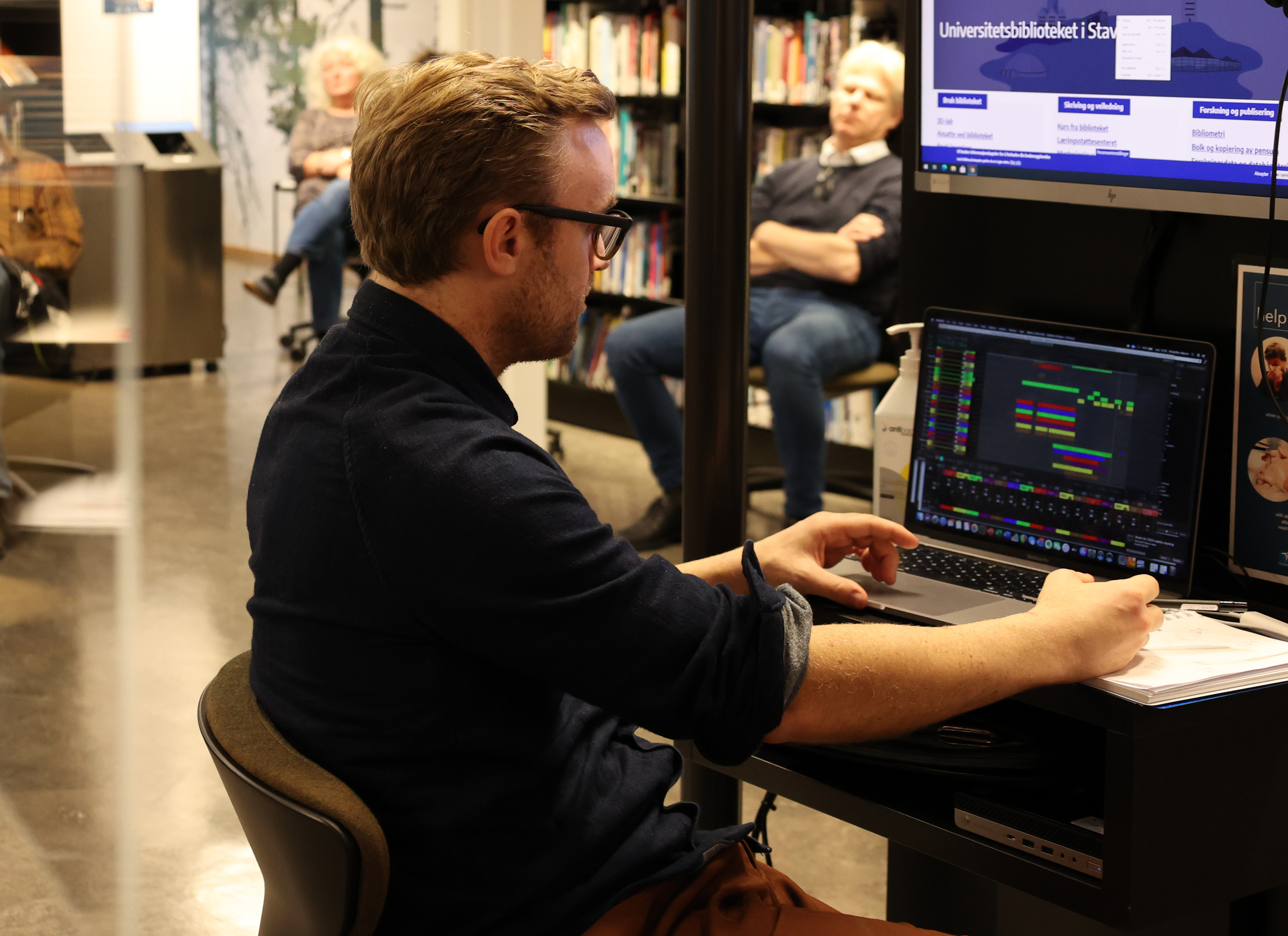
Alberts is a PhD fellow in the Department of performing arts. He explains his project this way:
"The starting point for my artistic research is a desire to locate reference points within various music improvisational models such as free jazz and English improvised music from the 1960s.
The reference points can be rhythmic figures, melodic and harmonic structures, but also less audible and defined points of reference such as abstract sonic textures, silence, repetition and form-based structures such as sonic drones and callback to previous musical acts.
As practitioners of the models, through collective practice and experience, we have established a foundation of knowledge blocks to deal with and make stylistically correct choices when these reference points arise in the music of the various improvisational models.
I want to use ethnomusicologist Bruno Nettl's improvisational theories as a framework for the research. As a solo saxophonist, as a band member of established ensembles and as a curator of new constellations and venues, I have an ambition to use the already established reference points and knowledge blocks to put together new models with defined reference points and continue how we practice and experience improvisational music.
One possible outcome would be to utilize knowledge from improvisational processes derived from noise music (focusing on the release Wake up awesome produced by Lee Spencer Yeh). In this less collective model, music can lose its owner by allowing other performers to use and manipulate the already recorded material in addition to new musical constructions using music production and digital software (DAW).
By adding elements of this anarchist, digital improvisational process into a more collective improvisational work with performers who have their experience and knowledge blocks derived from improvisational models such as jazz, rock, contemporary music and English improvised music, I see the opportunity to create new platforms for improvised music.
In the research I will focus on a breadth of musical models within the improvised music field, and the anarchist approach of music production in noise music. I would like to facilitate an improvisational process, where the improvisational qualities are well present by allowing those involved to use their improvisational knowledge blocks to the full, while at the same time facilitating the ability to manipulate and modify improvisational processes using simple compositional techniques (time marks, tonality, texture notes) and music production (edit and cut in the material)."
Green infrastructure for livable and sustainable cities
The project will study and develop knowledge and methods for a goal-oriented planning and management of urban green areas.
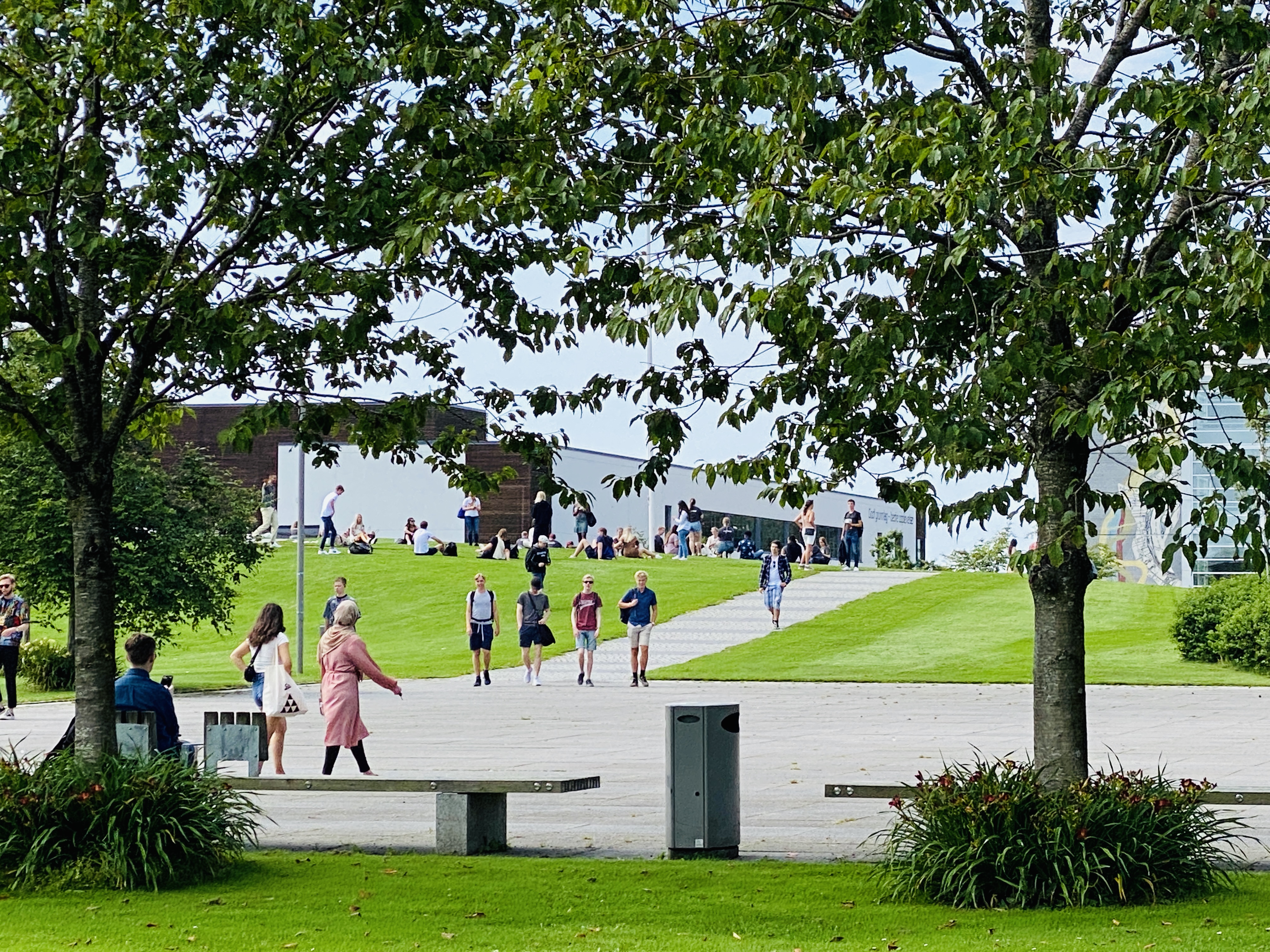
This will be based on indicators for assessing the goods and services of the ecosystem. Moreover, tools for analyzing urban planning and management is going to be developed as well as methods to describe multi-functionality, co-benefits and trade-offs across urban typologies and green infrastructures will be investigated.
Furthermore, it will be studied how the indicators can be operationalized to monitor and evaluate the quality of urban green areas, as well as to identify current challenges in urban planning and development. In the project, quantitative and qualitative analysis as well as fieldwork will be used. In addition, experimental design and statistical tools as well as Geographic Information System (GIS) will be used for the project.
The research project is a collaboration between University of Stavanger (UiS) and Norwegian Institute of Bioeconomy Research (NIBIO).
Doctoral fellow in the project: Maria Korkou, Department of safety, economics and planning.
An intelligent energy forecasting system for cluster of smart buildings
The main objective of this research is to develop an intelligent energy forecasting system by using machine learning (ML) techniques and while incorporating blockchain for secure transactions.

In the last few decades, there have been significant efforts in integrating renewable energy sources (RES) to the power gird. This allows end users to act as both consumers and producers (prosumers) by maximizing their profit while helping to maintain the balance of the grid.
Hence, the need for economic and control techniques to manage the flow of the existing electric power systems is essential. Moreover, the accurate and efficient energy forecasting mechanism is more useful to schedule energy exchange between the users and the grid.
However, there have been questions raised on how to improve the accuracy of energy forecasting as well as how to perform secure peer-to-peer (P2P) energy trading between the users and the electric grid.
Doctoral fellow in the project: Sasanka Niromi Ranasinghe, Department of Electrical Engineering and Computer Science.
Optimal densities to support a more sustainable urban environment
What are the optimal urban densities in relation to sustainable development within a medium-sized Norwegian city?
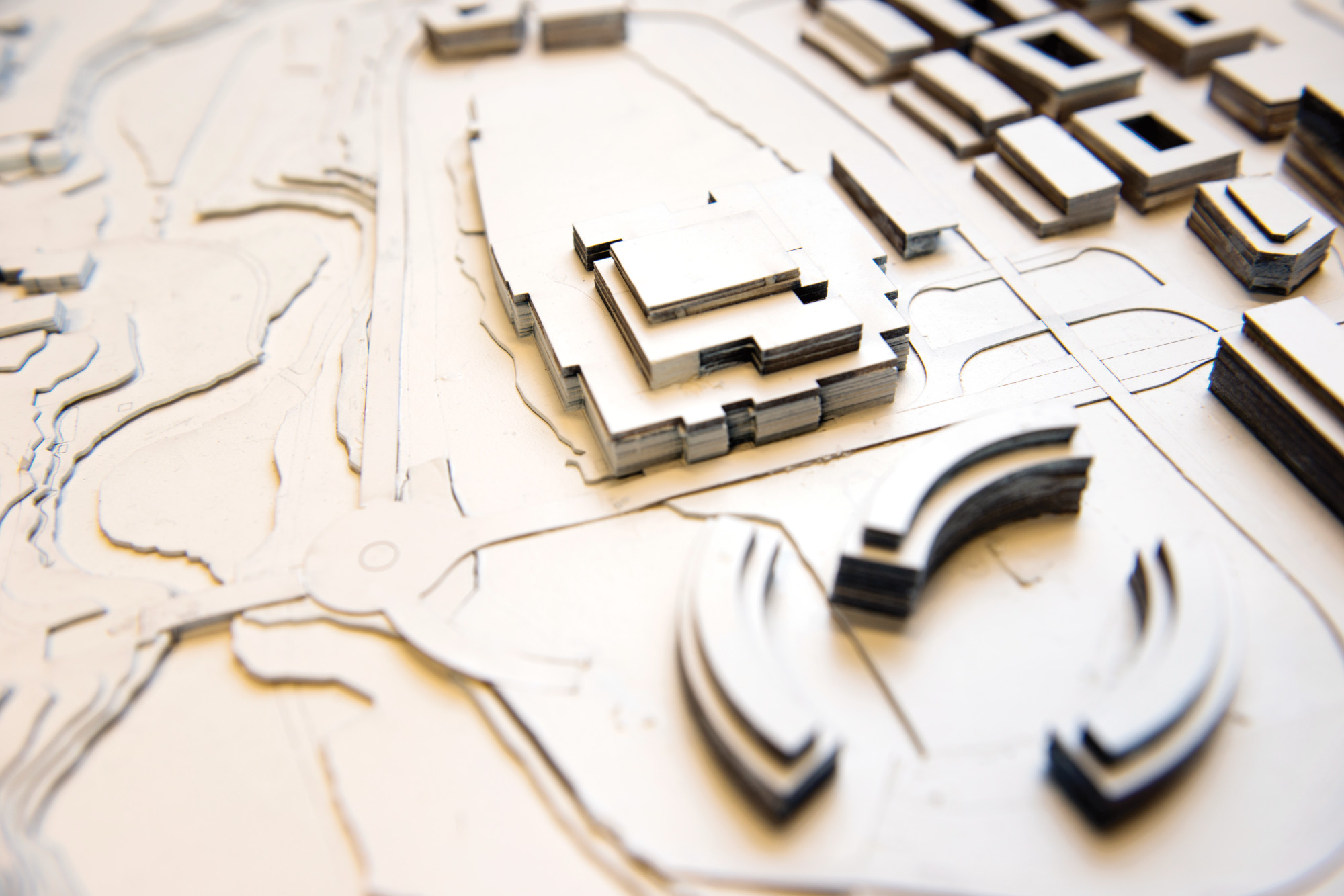
The idea of an 'optimal densities' threshold is central for the dissertation. It revolves around the possibilities to achieve the benefits of spatial concentration while simultaneously avoiding most of the problems that higher urban densities can foster.
In order to research this, different urban systems / services and their performance will be explored in regards to urban densities. Public transport, alongside energy distribution / consumption, waste management, access to social infrastructure and commercial services, has a vital importance for the functioning of any metropolitan area and thus, it is the urban system to be addressed.
Doctoral fellow in the project: Todor Kesarovski, Department of safety, economics and planning.
Tools to predict/simulate wind behaviour in urban environments
Better tools can aid architects and city planners in making better decisions regarding pedestrian wind comfort.
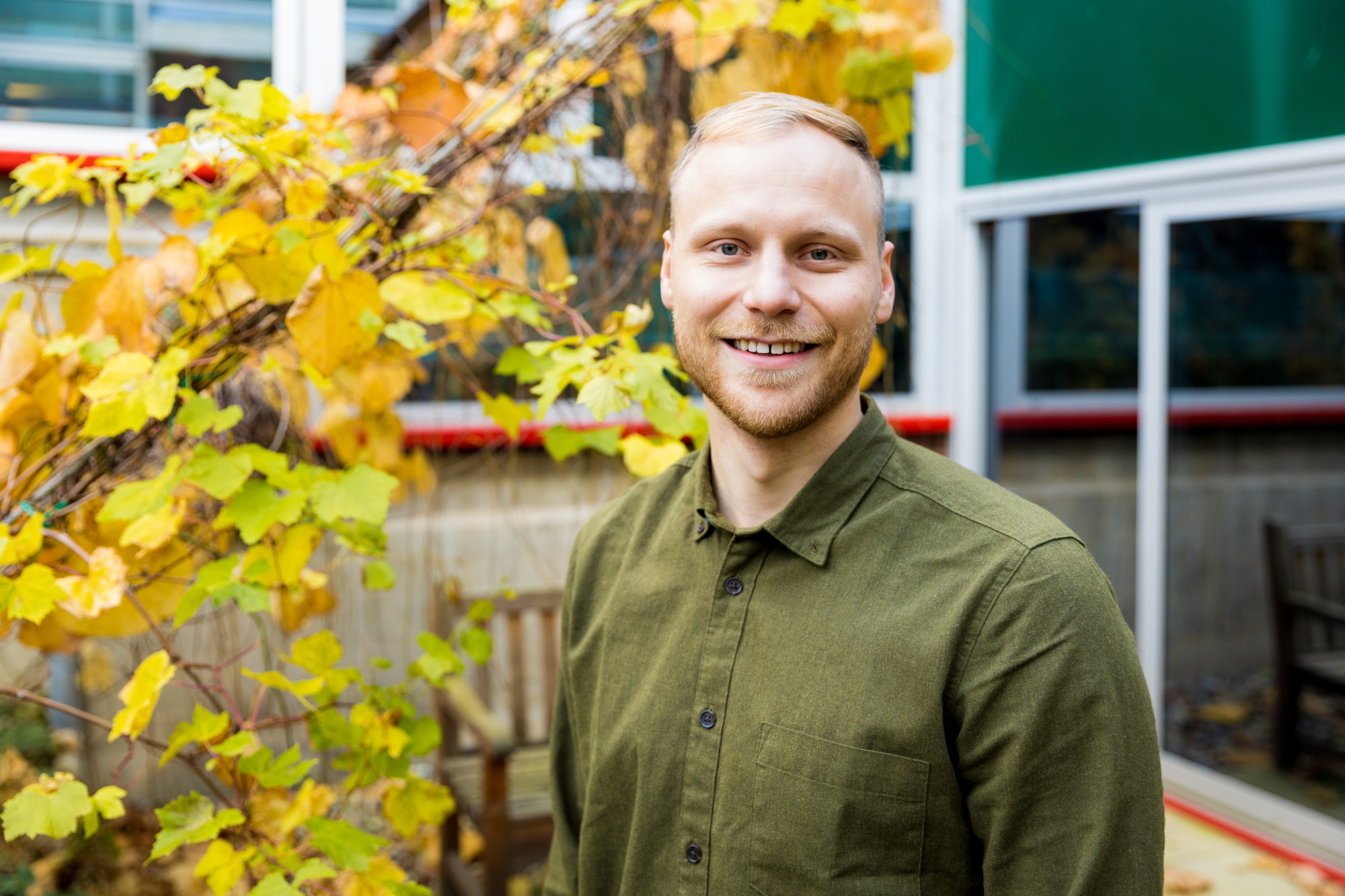
The focus of Trond-Ola Hågbo's PhD project is to develop efficient tools to predict/simulate wind behavior in urban environments. Improved tools can aid architects and city planners in making better decisions regarding pedestrian wind comfort.
Another utilization is to evaluate the feasibility of potential locations for wind turbines in urban areas. His research interests concerning smart cities are urban wind simulations and generations of realistic 3D models of urban areas.
Trond-Ola Hågbo is a PhD Candidate within urban wind simulations and renewable energy at the Department of Mechanical and Structural Engineering and Materials Science. He holds a M.Sc in "Energy, Climate and Environment" from UiT and is one of three Ph.D. candidates working on the Future Energy Hub as of spring 2020.
Future Energy Hub is a UiS based project collaborating with local industry partners, other research facilities as well as public institutions. The overall goal of the project is to accelerate the development of greener buildings and districts.
Intermediation in urban sustainability transitions
We aim to examine practical activities, processes, and structures that can promote strategic alignment and coordination between multiple actors in urban sustainability transitions.

The cities have now become key actors on the international agenda for sustainable development. The new wave of ‘government by experiment’ is emerging in order to stimulate rapid progress in urban transitions towards more sustainable modes.
Urban experiments take central stage to this actionable form of governance. Such experiments facilitate a process of development of more sustainable forms of socio-technical configuration through emergence of new ideas, practices, expectations, technologies, and social relations.
Alignment of these components normally requires a dialog between actors of multiple sectors involved. Intermediaries working between actors have a central role to play in actors’ interaction, joint activities and problem solving. In this project, we focus on the intermediary actors and processes behind urban transitions, such as individual actors (boundary spanners) functioning on micro-level of intermediation, and systematic intermediaries operating on the mezzo-level.
We aim to examine practical activities, processes, and structures that can promote strategic alignment and coordination between multiple actors in urban sustainability transitions.
Our primary objective is to further develop theoretical insights on intermediation by linking urban planning literature, transition theory and institutional theory.
Our secondary objective is to draw policy insights for integrative experimentation, adaptive planning and urban governance. We conduct multiple case studies of urban experimental projects in the municipality of Trondheim, Norway. By deploying non-participatory observations and qualitative analysis, we obtain in-depth insights into how intermediaries function and how intermediation occurs in urban experimentation.
Doctoral fellow in the project: Veronika Budowska, Department of Media and Social Sciences.
Smart security & system adaptation in smart cities
This research project will focus on smart security and system adaptation, interoperability and flexibility in a “Smart City” context.

Doctoral fellow in the project: Viktoria Gierukas, Department of safety, economics and planning.
This research project will focus on the topic Smart Security and System Adaptation, Interoperability and Flexibility in a context of “Smart City”. Furthermore, I will examine how features of the “smart city” - features that connect people, objects, and infrastructure - can adapt to an increased threat - targeting society, the economy, or infrastructure - thus enabling cities to respond more rapidly, timely and extensively.
There is no literature that have analyzed “smart security” in a smart city concept and how this can prevent or mitigate the impacts of various threats. “Smart security” is mentioned in the literature but it is not defined or explained in any significant detail, which means that the term remains undefined and unrefined.
Smart security acknowledges the importance of safety and security, but there is still lack of explanation for which security measures can be implemented in smart cities and what effect this can have on cities and their citizens’ safety.
This project will therefore focus on the term “smart security” and thereby fill the gap in academic knowledge about “smart security” in smart cities. By doing so, I will establish and define “smart security” in a context of smart cities. Further, a focus will be placed on integrated technology systems – CCTV, radio frequency jamming, Geofencing, smart communication etc. - that can make cities or soft targets more resilient against various threats.
Nevertheless, it is important to illuminate that these systems provides opportunities and wider implications in surveillance cities that will be address throughout this project.
The use of digital systems can help increase efficiency and perhaps make cities more safe and secure, but there are also risks involved in implementing such systems. It will therefore be important to highlight both the advantages and disadvantages such systems can provide for smart cities.
Smart city as a policy
A comparative study focusing on the role of open innovation in smart city projects

Smart city policy has tremendous impact on shaping future ways of living and improving quality of life. According to Eurostat (2014), more than half of the world’s population lives in urban areas. Despite that urbanization process brings lots of opportunities, the increase of urban population is a challenge for cities all over the world.
With the advancement of digital technologies, smart city as a concept was first raised by IBM in 2009. As a relatively novel concept, research on smart city is still in a nascent stage and the level of smart city development varies across cities. Therefore, it is critical to conduct clearly structured research project to access how local context impact the implementation of smart city policy and how to implement smart city policy effectively and efficiently according to different local context and political processes and what are the impacts on regional development and innovation.
The main goal of this proposed research project is to understand how local context and political processes affect smart city policy implementation. The secondary goal is to uncover the role open innovation plays in initiating and implementing smart city policies in different cities.
In the past, there are many researches and case studies on implementation of the smart city concept and best practices in certain regions. From existing studies and researchers, one of the common aims of building smart cities is to increase quality of city life. Broadly speaking, citizens, companies, and governments are all owners and stakeholders of smart cities. In order to create desirable smart cities, citizens, companies, and governments need to work together. Therefore, I assume open innovation model and smart city policy are inextricably linked and the role open innovation plays in smart city projects is worth exploring.
Since many researches on open innovation and smart cities were focusing on single country or single region, my proposed research projects will conduct a comparative case study.
Doctoral fellow in the project: Xiangyu Quan, UiS Business School.
Designing digital intervention
A design thinking approach to inspire change in young people who are not in employment, education or training.

This project explores the design and development process of an interactive app teaching growth mindset targeted towards youths not in education, employment or training. The idea is that the app can help speed up youth’s own capacity for change.
The app will be designed through a design thinking / human-centered design process where capturing the subjective experiences of the end-users in situ is an essential part of the problem solving process. Artefacts, prototypes and user tests inform the design process and can generate new knowledge about youths and their contexts.
The latter has a wider application beyond the design process of the app. Thus, this PhD-study uses design in two distinct ways, it is doing “design as part of doing research”, and doing “research through design”, i.e. using designed objects and the design process to generate knowledge about people and their contexts.
Doctoral fellow in the project: Ingjerd Jevnaker Strand, Department of social studies
Green with a screen
Performing environmental citizenship in the smart city.

Approximating sustainability in a world burdened by economic and environmental crises demands the cultivation of an active citizenship that steers unfolding innovations toward embodied practices of care.
This project examines the sustainability of smart energy infrastructure by exploring how technology-mediated participation in urban ecosystems is transforming the relationship between humans and their natural environments.
Taking the smart city initiative in Stavanger as a case study, this research combines ecocritical studies of energy and data infrastructure with science fiction literature to radically detrivialize and criticize our everyday interactions with forces of nature through power plugs, electric grids, solar panels, and digital screens.
The aim of this project is to clarify the roles of technological and critical energy literacy in maintaining sustainable modes of urban dwelling that reflects our indebtedness to the vibrant forces of nature and the human and nonhuman bodies that we share our environments with.
Doctoral fellow in the project: Mehdi Torkaman, The Greenhouse, Department of Cultural Studies and Languages.
Triangulum: Smart cities, sustainable societies
Triangulum was an EU Horizon 2020 Lighthouse project, aimed at transforming designated urban districts into smart quarters in three forerunner cities and then transfer the concepts to three further cities.
The project ran from 2015 to 2019, and involved 23 European partners from urban municipalities, research, and industry. Visit the EU Triangulum website here.
As one of those partners, University of Stavanger researchers contributed to the project with cloud computing technology and energy efficiency expertise. Local partners were Stavanger municipality, Rogaland county, Lyse AS and Greater Stavanger.
Three cities
The project implemented pioneering concepts in the three cities of Manchester (UK), Eindhoven (Netherlands), and Stavanger (Norway) with support from the European Union. Follower cities were Leipzig (Germany), Prague (Czech Republic), and Sabadell (Spain).
See it for yourself!
Here are some videos about the project (links to YouTube):
Stavanger's Triangulum project (YouTube)
University of Stavanger scientists explain the use of big data
"Tour de Triangulum" bus ride in Stavanger, June 2017





